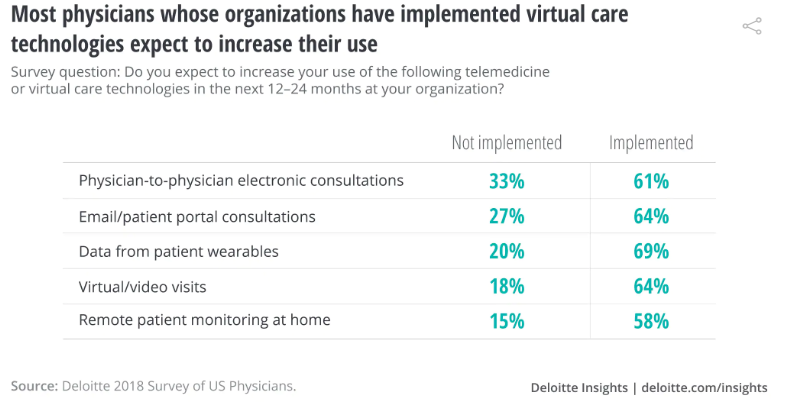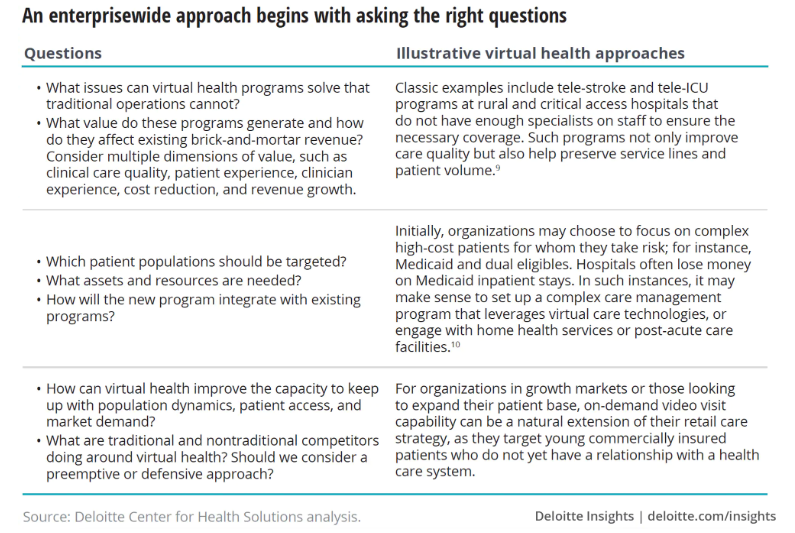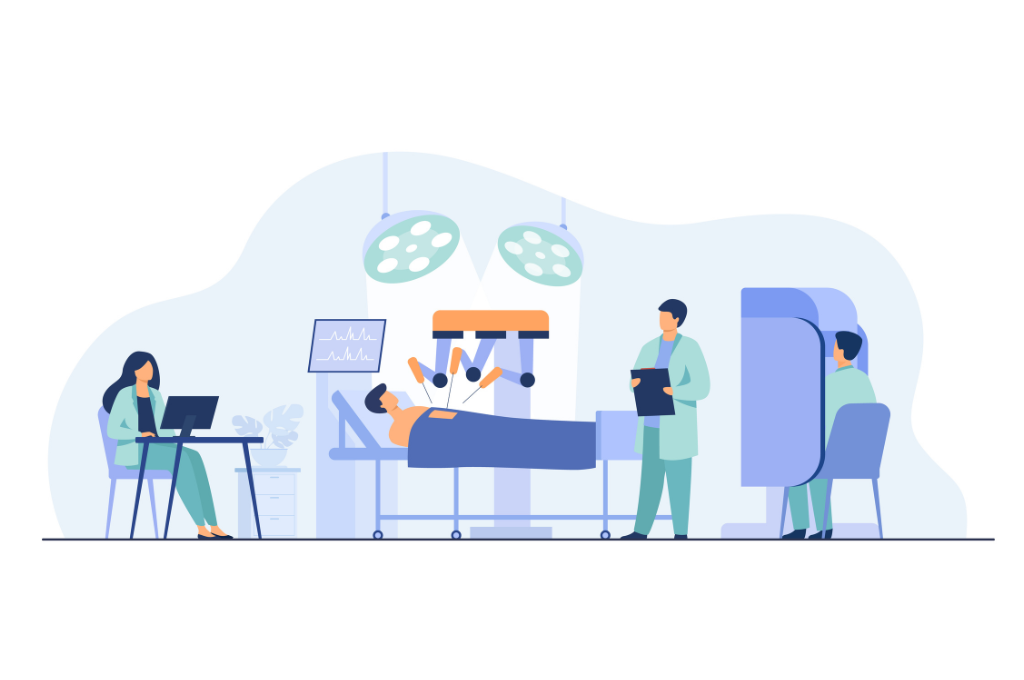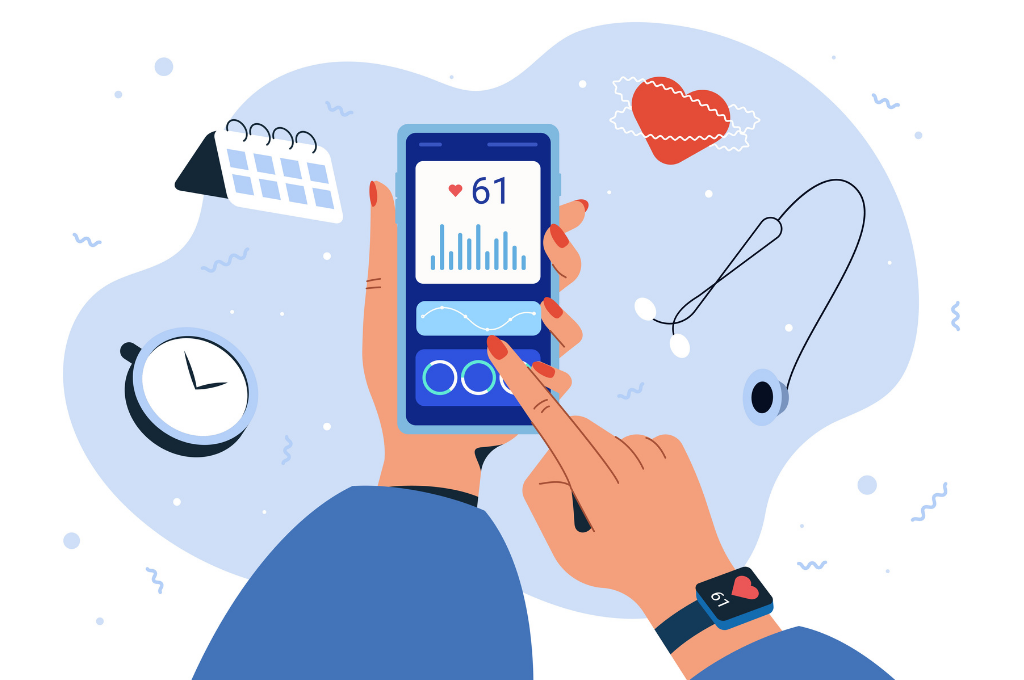2020 is the year of digital health industry with technology-driven apps and portals. The U.S. healthcare market was valued at US$ 144.2 billion in 2018 and is predicted to grow to US$ 280 billion by the end of 2020.
The reason behind the digital health transformation is rising health care costs, changing patient demographics, evolving customer expectations, emerging market entrants, complex health, and technology ecosystem.
.png?width=1024&name=virtual%20health%20(1).png)
The state of digital transformation in healthcare in 2020 looks quite promising, doesn’t it?
2020 comes with a lot of innovations and advancements in the healthcare industry. The advancements in digital technologies will create enormous new responsibilities and opportunities for the doctors as well as patients.
"Digital Transformation in Healthcare" is the new "now" and is shaping the future of health care systems.
What’s driving digital health?
- Need for predictive and preventive care
- Less cost and precise medical treatments and therapies
- Increase Consumer/patient demand
key takeaway
- Improving the health of the huge population requires new-age models and technologies that address the drivers of health, enable early diagnosis, and continuously monitor response to treatment.
- Technology-driven doctor-patient interaction, patient engagement strategies are enabling increased financial independence for patients in their health care decisions.
- Governments around the world are also taking initiatives by adopting health coverage and introducing pricing controls and medical technology devices.
- The cutting-edge technologies like Cloud computing, 5G network, Artificial Intelligence, Natural Language Processing (NLP), and the Internet of Medical Things (IoMT) help streamline health care services with rapidly changing consumer preferences.
- A technology-enabled model has the potential to change ‘physicians’ future roles in delivering health care services, infrastructure, and enablement.
- Health care stakeholders are introducing payment reforms such as value-based payment models that help patients achieve the best outcomes at the lowest cost.
- Health care systems can also link digital offerings to strategically segmented customer experience and invest in core analytics to create a 360-degree view of the consumer eliminating any operational barriers.
Key Trends Showcasing Digital Healthcare Technologies In 2020
As the new innovations continued to emerge, we can only expect advanced health care trends in the near future. With this, we’re bound to come across new advancements in the digital health industry that will reshape its landscape.
Here are some key trends showcasing digital healthcare technologies in 2020:
`
5G- a new generation network for instant healthcare
The next key trend, 5G technology is all about real-digital interactions. The next-generation technology network 5G makes it possible for patients to be treated remotely via computer or mobile device. Also, they’ll be sharing their patients report online, online appointments, video consultation that involves human interaction in real-time.
-
Doctors could soon use ultra-reliable connections to teleport to virtual environments and perform robotic surgeries.
-
5G also facilitates medical training, leveraging students to use virtual reality headsets so that they can practice the steps of complex surgeries at their own pace.
-
5G enabled drones could deliver life-saving medicine or devices to patients in rural areas.
-
5G allows instant streaming, downloading, and uploading of healthcare-related data. For Telemedicine, this means patients will experience better video conference quality, irrespective of location.
-
Doctors will have access to accurate, real-time imaging of organs, soft tissue, and bones.
According to Qualcomm, the world’s largest mobile chipset supplier said,” The technology can run up to 100 times faster than the current cellular connection, which made industry experts confident that it will completely change the healthcare landscape and lead to savings of up to $650 billion by 2025.”
Qualcomm said,” 5G is designed to pair with technologies like artificial intelligence and XR to enhance current services and applications, offering a different level of user experiences”.
Importance of big data in healthcare
Big data collects information about a business through various platforms such as social media, eCommerce, online transactions, and financial transactions.
The benefits Big Data provides several benefits, including:
-
More Accurate staffing: Big data predictive analysis help hospitals and clinics estimate future admission rates that help facilitate allocate the proper staff to deal with patients. It saves money and reduces waiting time in emergency cases.
-
Reduce the rate of medication errors: Via patient record analysis, the software can raise any inconsistencies between a patient’s health and drug prescriptions. It helps in alerting health professionals and patients when there is a potential risk of medication error.
-
Facilitating Preventive Care: It facilitates preventive care as a large volume of people stepping into emergency cases are recurring patients also called “frequent flyers”.
Healthcare and pharmaceutical companies should invest in managing the data while keeping these benefits in mind. The Drug business owners believes that big data helps them to understand the market trend.
And with that, they can identify product iteration and product budgets based on existing and future demands.
Read also: TeleHealth :Connecting Patients to digital health
The evolution of Internet Of Medical Things ( IoMT)
IoT development plays a critical role in tracking and preventing chronic illness for many patients via devices and mobile apps. The integration of IoT with Telemedicine and Telehealth technologies lead to the evolution of a new Internet Of Medical Things (IoMT).
The technology involves a number of wearables, including ECG and EKG monitors. The measurements such as skin temperature, glucose level, and blood pressure readings can be done with the wearables and devices.
According to Frost & Sullivan, nearly 60% of operations in the healthcare industry adopted IoT or IoMT systems. Nearly, between 20 and 30 million IoMT devices are expected to be deployed by 2020.
The IoT trend has changed everything from patient experience to market profits.
According to the Allied market research report, the coming year 2021, is all set the market for the IoT devices in healthcare which is anticipated to reach $136 billion.
Wonders of Artificial Intelligence
Artificial Intelligence is the most advanced and multifaceted technology among all the others. The technology facilitates the company’s aggregate and synthesizes information that’s required for clinical trials, thus shortening the drug development process.
The technology process information and provide decision making data in a similar manner as a human does. It understands the nature of the disease, establish bio-markers, generate data models, execute pre-clinical experiments, and even analyze the real-world experience.
AI applications facilitate the improvements in the speed and accuracy of the diagnosis processes.
FDA has recently approved the first AI-based diagnostic device, a system that examines eye disease by analyzing photos of the retina. High-quality images are uploaded, and the algorithm then proceeds further to check for possible indications of diabetic retinopathy. The software correctly identifies individuals in 87% of cases, and also 90% without the disease.
Chatbots do it all alone
Daily routine queries using AI-backed messaging and voice systems help organizations realize cost savings. Chatbots in healthcare assist doctors in easy diagnosing of disease and also permits them to focus on matters that might required instant attention of doctors.
The global healthcare Chatbots market is projected to reach $314.3 million by 2023 from $122 million in 2018.
.png?width=1024&name=virtual%20health%20(2).png)
Health Startups Delivering Digital Healthcare
Here are some health startups putting their best initiatives in delivering the best digital healthcare to their patients.
Ciitizen
Startup Ciitizen is working for the welfare of cancer patients by developing technologies that facilitate them with best medical services. Ciitizen provide services to collect, summarize and share your medical records digitally and free of charge. It also facilitate to get a second thought, coordinate with caregivers, or even you can contribute to research.
Omada Health- Bringing human connection to digital care
Omada Health is a behavioural health startup founded in 2011. It benefits individuals who are paying for care, and also the entire system.
Omada health uses the latest technology to bring real, human support to help people achieve health goals through sustainable lifestyle change. Omada launched customized digital care programs for prevention, type 2 diabetes, hypertension, and behavioral health to address the complete health patterns of the person.
Stuward is a Switzerland based healthcare company that recently launched a Telemedicine application named Stuward VU amid the roll-out of 5G. The application facilitates connect medical professionals with people looking for online consultations.
Virtual care is a must-have for physicians
The adoption of virtual healthcare practices is increasing year by year. See how physicians-to-physicians have implemented 61% electronic consultations. 64% is the patient portal consultations via emails. And no. of remote patients taking treatment from home are 58%.

The enterprise-wide approach begins with the right set of questions about virtual health care.

Source: Deloitte
Concluding Thoughts
A big thanks to technology, as with this patients get better medical treatment with virtual reality tools, wearable medical devices, Telehealth, and 5G mobile technology. Caregivers can also streamline their workflows using cutting-edge technologies like Artificial Intelligence systems.
The potential of all the technologies to create synergies that yield digital transformation in healthcare is immense. The large ecosystem is expected to become more independent as the industry moves forward.
As a business enterprise, Classic Informatics goal is to develop the best products and services that improve customer’s lives and at the same time provide an inevitable user experience. With our healthcare digital solutions, we serve this goal. Connect with us to get the best solution for transforming health into digital health.

























